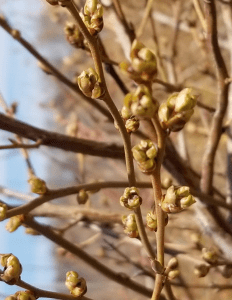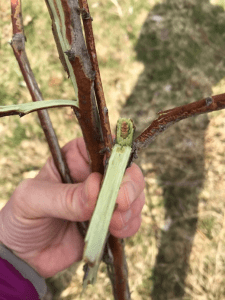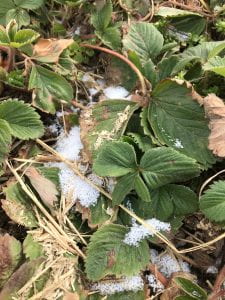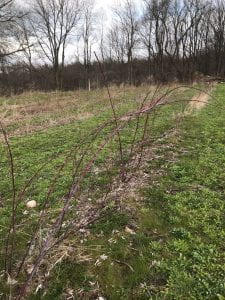Berry Office Hours Reminder
Weekly Berry Office Hours held on Thursdays at 12:30pm via Zoom or on your phone. Format will be a short, in-depth presentation about a production issue and then Q&A. Join each week, or view recordings that will be posted.
Thursday, April 23 – Managing Botrytis in June Bearing Strawberries
Click link below to join the Berry Office Hours
https://cornell.zoom.us/j/95514586018
Meeting ID: 955 1458 6018
One tap mobile
+16465189805,,95514586018# US (New York) 16468769923,,95514586018# US
+(New York)
Join by Skype for Business
https://cornell.zoom.us/skype/95514586018

Eastern NY Berry Crops “To Do” List:
Heat accumulation has slowed to nearly a standstill up and down the eastern NY region, and many areas have had snow and significant frost events – this weather pattern seems like it will be in place for at least the next week. This might allow for some last minute herbicide applications, but it’s very important to check your crop, in your area before you apply.
Blueberries:
- Blueberries are slowly moving past tight cluster in the south and late bud swell from the central Albany area north. In those northern plantings there is still a window of opportunity for pruning if plants really need it.
-

Corky brown tissue in branch cortex may be a sign of Phomopsis canker. I saw what we believe to be phomopsis canker damage in plantings. This damage is tricky to detect and to ID because it looks a LOT like winter injury. If you are seeing newer canes with the growing tip dying out – which causes them to break lateral buds too low, you may have a canker problem. If you cut the cane open you might see the corky brown tissue that can be attributed to Phomopsis damage. Lime sulfur and copper sulfate should be applied before bud swell; Pristine, Quash and other fungicides could be applied safely a bit later but the best control will be earlier.
- Check for rodent activity in plantings – burrowing holes, chewing etc. and make a note to place bait stations in planting in early November. Reduce habitat where possible.
- Make plans to introduce bumble bee hives into the planting if pollination hasn’t been as strong as you would like.
- Green tip sprays for Mummyberry and Botrytis should be applied soon. Abound and Indar are labelled for both diseases, but there are other choices as well. Again – check the Guidelines or the label.
Raspberries/Blackberries
- Raspberries are at 1-3” in the south and budbreak from Albany north. So far, no damage has been reported.
- You can still thin floricane raspberries to the appropriate density – 4-6 canes per square foot of row. Rows should be no wider than 18” preferably 12” wide. Remove small canes (diameter less than a Sharpie) that will not contribute to overall productivity.
- Later plantings can still spray for Anthracnose, Spur Blight and Cane Blight. Lime sulfur is labelled for all three, but if you don’t like using it there are many other choices.
Strawberries
- Strawberries have been reported to be in bloom in plantings that have row cover over them. Keep that row cover in place, and maybe use overhead sprinkling to protect blossoms during this cold period ahead. The flowers are the most vulnerable stage to cold damage.
- High tunnel strawberries should be on the lookout for mites which thrive in hot, dry conditions. The scouting threshold is 1 mite per leaf on at least 15 leaflets out of 60 samples OR 5 mites/leaf. Don’t let mites get ahead of you. Many different pesticides including JMS Stylet Oil which is organic and Agri-Mek, Kanemite and Acramite. Mites are also present in field strawberries although they probably aren’t too active yet, given the cold – early season scouting would be prudent.

Ribes
- Just starting to push – in southern areas they will set flower quite early.
- Powdery mildew sprays (many organic options including oil, Kailgreen, sulfur and Actinovate, but also Rally, Cabrio and Rampart) should begin now if this has been a problem in the past.
Western NY Scouting Notes

Strawberries: Minimal development as weather has been cold. Maybe a few new leaves, but no floral buds yet. Some leaves are showing cold/frost damage, but these early leaves will be quickly replaced, so not a major concern. I find this sometimes difficult to distinguish from cyclamen mite damage, as malformation is a symptom of both.
I’m seeing aphid eggs and some live aphids, but also some predators, so probably best to give the predators a chance to manage the pests rather than trying to spray this early. As the weather warms soon (hopefully!), consider protectant sprays for leaf diseases, as young leaves are most susceptible to infection.
Blueberries: In colder areas, buds haven’t budged since last week – mostly at budswell. In warmer areas, including Southern Monroe County and northern Finger Lakes area, buds have moved to tight cluster. See Laura’s comments above on mummyberry and botrytis sprays – these should start going on as soon as reasonably possible. A colleague reported that she is seeing winter damage when cutting blueberry buds, we will see if this becomes more widespread with such cold weather.

Raspberries: Development about the same as last week. See Laura’s comments above on pruning. For plantings with a history of Phytophthora Root Rot infection, this is the time to apply Ridomil Gold. Aliette, Phostrol, Rampart and Prophyt are also labeled, but should be applied later – see Cornell Guidelines or product labels for details. For organic growers, Actinovate and Rootshield may help prevent Phytophthora, but are unlikely to cure it. As black raspberries come out of dormancy, this is the time to prune out winter damage and establishing the summer height for the floricanes.
